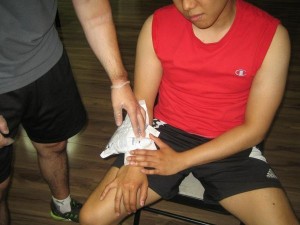Carpal tunnel syndrome involves irritation of the synovial membranes surrounding the tendons in the carpal tunnel. It is important to note that this inflammation adds up pressure on the median nerve which travels from the forearm into the hand via a tunnel in the wrist. The sides and base of this tunnel are formed by the wrist bones while the upper part of the tunnel is concealed by a durable band of connective ligament or tissue.
The tunnel is also comprised of 9 tendons that are responsible for connecting muscles to bones as well as allowing the individual to bend the fingers and thumb. Remember that these tendons are covered with a lubricating membrane known as synovium that has the tendency to enlarge and swell under certain situations.
In case the swelling is evident, it can cause the median nerve to be compressed up against this durable ligament that results to tingling, numbness or pain. All of these are indicative signs of carpal tunnel syndrome.
What are the indications of carpal tunnel syndrome?
If an individual suspects that he/she has carpal tunnel syndrome, the following signs and symptoms are present:

- Tingling and numbness in the hands
- Tingling sensation over the wrist
- Diminished sensation in the fingers and thumb
- Pain when the wrist is held in a bent position for an extended period
- Nerve conduction test result is positive
Possible causes of carpal tunnel syndrome
Carpal tunnel syndrome can be triggered by factors that irritate the synovial membranes surrounding the tendons in the hands and as a result, add pressure over the median nerve. Some of the usual causes include the following:
- Overuse
- Constant grasping using the hands
- Repetitive bending of the wrist
- Fractured or dislocated wrist bones that leads to swelling
- Rheumatoid arthritis
- An increase in the duration and intensity of exercise and using incorrect equipment
- Diabetes
- Thyroid gland imbalance
- Hormonal changes linked with menopause
Management of carpal tunnel syndrome
When treating carpal tunnel syndrome, the initial line of treatment is the RICE method (rest, ice, compression and elevation). For mild cases, they are managed by applying a splint or brace usually worn at night in order to prevent the affected wrist from bending. By resting the affected wrist, it allows the inflamed and swollen synovial membranes to shrink in size, thus relieving the pressure off the nerve.
In most cases, anti-inflammatory medications are given to help reduce the pain and inflammation. As for severe cases, the doctor might recommend a cortisone injection. Once administered, it spreads around the inflamed synovial membranes that surround the tendons and shrinks them, thus relieving the pressure on the median nerve.
Take note that the effectiveness of the non-surgical treatment options usually depends on early diagnosis and treatment of the condition. Among those who do not gain relief from the non-surgical treatment options, surgery might be required.
